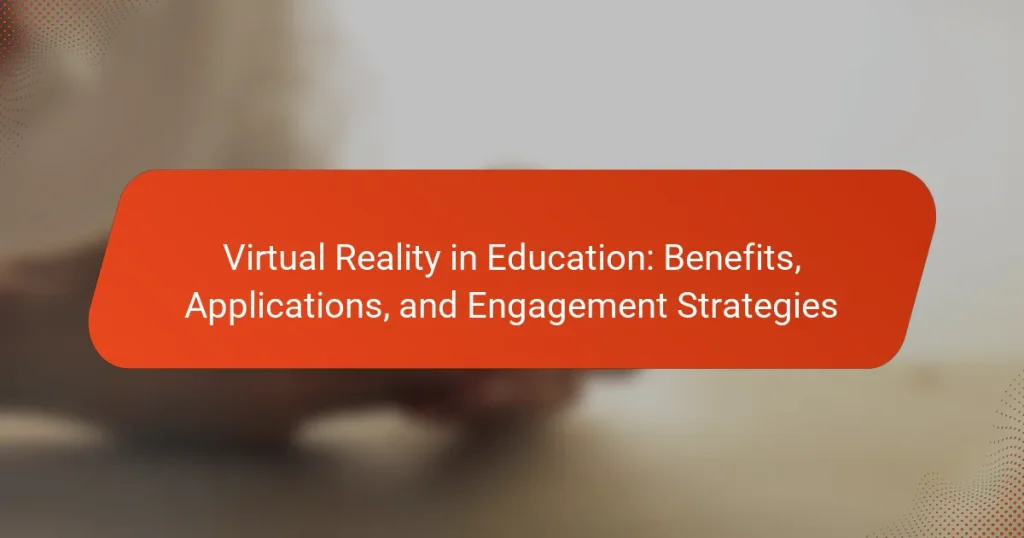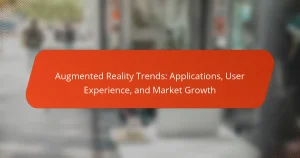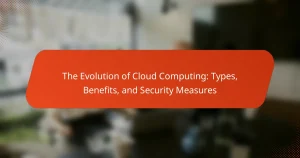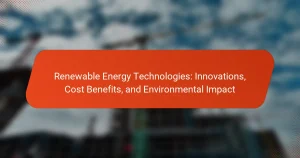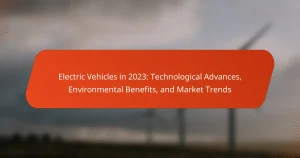Virtual Reality (VR) in Education is an immersive technology that simulates real-world environments, enabling students to interact with 3D spaces using headsets and controllers. This article explores the benefits and applications of VR in various subjects, including science, history, and art, highlighting its potential to enhance learning through engaging, hands-on activities. Research indicates that VR can significantly improve retention rates and student engagement, with findings showing that students using VR scored higher on assessments compared to traditional methods. The article also discusses effective strategies for educators to implement VR in the curriculum, emphasizing the importance of teacher training and equitable access to technology to maximize its educational impact.
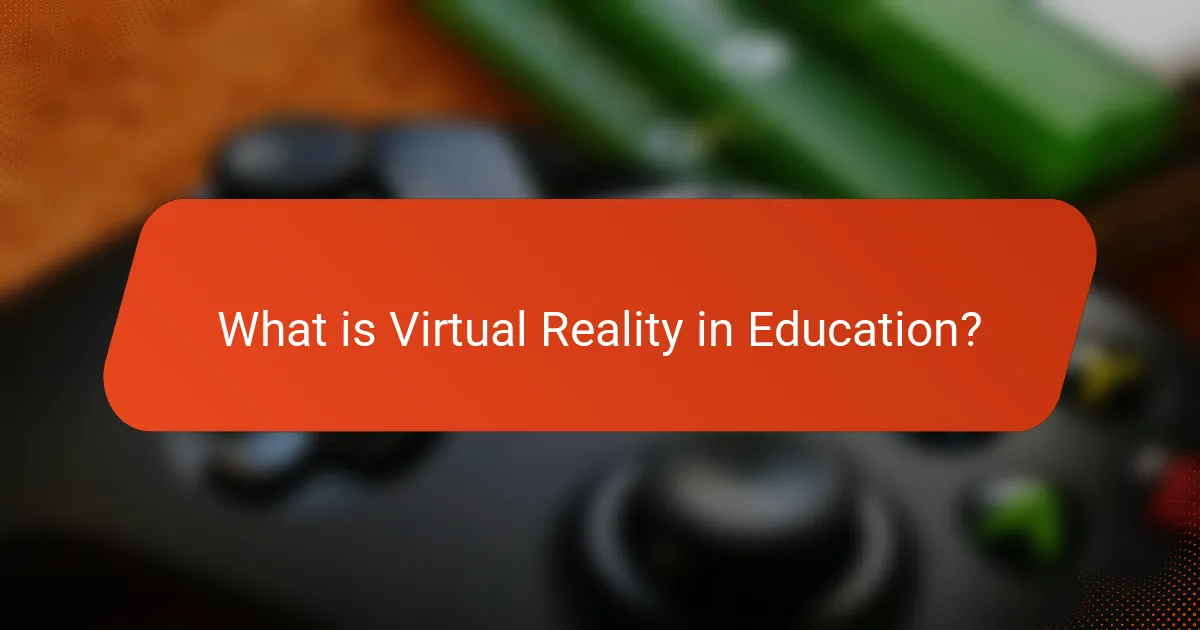
What is Virtual Reality in Education?
Virtual Reality in Education is an immersive technology that simulates real-world environments. It allows students to interact with 3D spaces using headsets and controllers. This technology enhances learning experiences by providing engaging, hands-on activities. Virtual Reality can be applied in various subjects, such as science, history, and art. For instance, students can explore historical sites or conduct virtual science experiments. Research shows that Virtual Reality can improve retention rates and boost engagement. A study by the University of Maryland found that students using Virtual Reality scored 30% higher on tests compared to traditional learning methods. This demonstrates its effectiveness in enhancing educational outcomes.
How does Virtual Reality transform traditional learning environments?
Virtual Reality (VR) transforms traditional learning environments by providing immersive experiences that enhance engagement. It allows students to interact with 3D models and simulations, making abstract concepts more tangible. This technology fosters experiential learning, enabling learners to practice skills in a safe, controlled setting. Research indicates that VR can improve retention rates by up to 75% compared to traditional methods. Additionally, VR accommodates diverse learning styles, catering to visual, auditory, and kinesthetic learners. It also breaks geographical barriers, allowing remote collaboration and access to resources. Overall, VR significantly enriches the educational experience by making learning more interactive and effective.
What technologies are used in Virtual Reality for education?
Virtual Reality in education utilizes several key technologies. These include head-mounted displays (HMDs) like Oculus Rift and HTC Vive. Motion tracking systems enhance user interaction within virtual environments. 3D modeling software is used to create immersive educational content. Game engines such as Unity and Unreal Engine facilitate the development of VR applications. Additionally, haptic feedback devices provide tactile sensations to users. These technologies collectively enable immersive and interactive learning experiences.
How do students interact with Virtual Reality in educational settings?
Students interact with Virtual Reality (VR) in educational settings through immersive experiences. They use VR headsets to explore virtual environments related to their curriculum. This interaction enhances engagement and motivation. Students participate in simulations that replicate real-world scenarios. For example, they can conduct virtual science experiments or explore historical sites. Research indicates that 90% of students reported increased interest in subjects after VR experiences. Additionally, VR facilitates collaborative learning. Students can work together in virtual spaces, fostering teamwork and communication skills. Overall, VR transforms traditional learning into interactive, experiential education.
What are the key benefits of using Virtual Reality in education?
The key benefits of using Virtual Reality in education include enhanced engagement, improved retention, and experiential learning opportunities. Virtual Reality immerses students in interactive environments. This level of engagement can lead to increased motivation and interest in the subject matter. Research shows that students who use Virtual Reality retain information better than those who learn through traditional methods. A study published in the journal “Computers & Education” found that students using VR scored 20% higher on tests compared to their peers. Additionally, Virtual Reality allows for real-world simulations that are not easily replicated in a classroom. This hands-on experience can deepen understanding and application of complex concepts.
How does Virtual Reality enhance student engagement and motivation?
Virtual Reality enhances student engagement and motivation by providing immersive learning experiences. These experiences allow students to interact with content in a 3D environment. This interaction promotes active participation, making learning more enjoyable. Studies show that students using VR are more likely to retain information. For instance, a study by Mikropoulos and Natsis (2011) found that VR improves learning outcomes in science education. Additionally, VR can simulate real-world scenarios, making lessons relevant and practical. This relevance increases student interest and motivation to learn. Overall, VR transforms traditional learning into an engaging adventure.
What impact does Virtual Reality have on knowledge retention?
Virtual Reality enhances knowledge retention significantly. Studies show that immersive experiences in VR increase engagement and motivation. This heightened engagement leads to better focus and information absorption. Research by Mikropoulos and Natsis (2011) indicates that students using VR retained information longer than those in traditional learning settings. Additionally, VR allows for experiential learning, which reinforces memory through practical application. The combination of visual and interactive elements in VR creates a multi-sensory learning environment. This environment is proven to facilitate deeper understanding and recall of information. Therefore, Virtual Reality positively impacts knowledge retention in educational contexts.
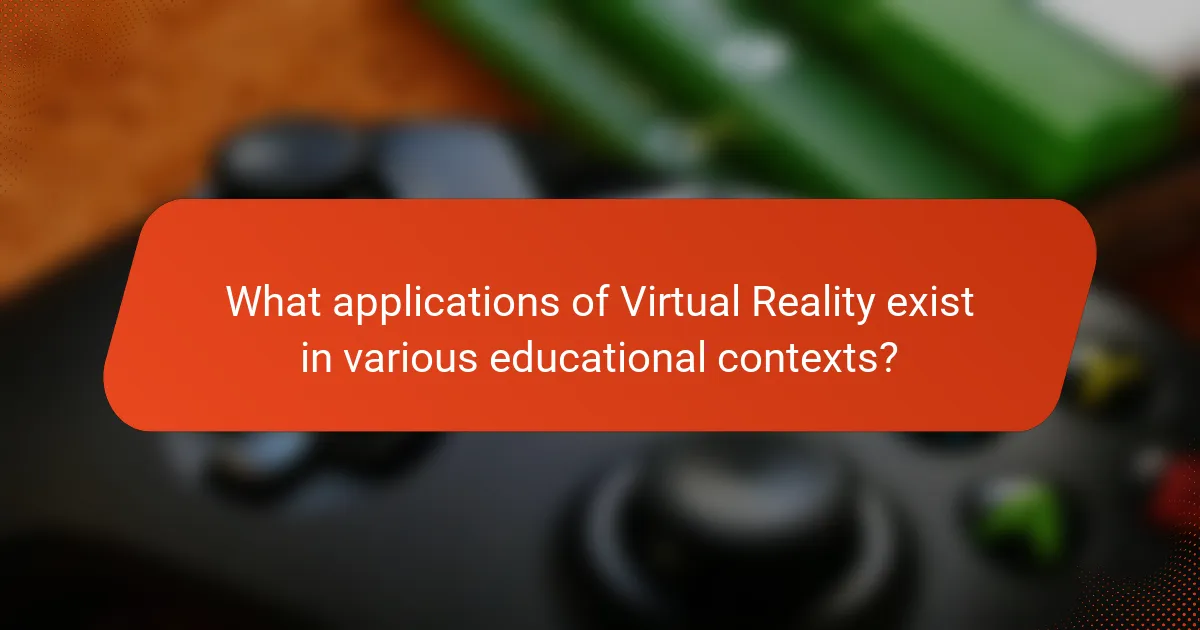
What applications of Virtual Reality exist in various educational contexts?
Virtual Reality (VR) has numerous applications in educational contexts. VR is used for immersive simulations in fields like medicine and engineering. Medical students practice surgeries in a risk-free environment using VR. Engineering students visualize complex structures and systems through 3D modeling. VR facilitates virtual field trips to historical sites, enhancing geography and history lessons. Language learners engage in interactive environments, improving conversational skills. VR also provides training for emergency responders in realistic scenarios. Research indicates that VR can increase engagement and retention rates among students. A study by Radianti et al. (2020) found that VR significantly boosts learning outcomes in various educational settings.
How is Virtual Reality used in STEM education?
Virtual Reality (VR) is used in STEM education to enhance experiential learning. VR allows students to engage in interactive simulations of complex scientific and mathematical concepts. For example, students can explore the human body in 3D anatomy lessons. They can also conduct virtual chemistry experiments in a safe environment. Research indicates that VR increases student motivation and retention of information. A study by Mikropoulos and Natsis (2011) found that students using VR scored higher in science assessments. Additionally, VR fosters collaboration among students in virtual labs. This immersive technology provides hands-on experiences that traditional methods cannot offer.
What specific subjects benefit from Virtual Reality applications?
Specific subjects that benefit from Virtual Reality applications include science, history, and medical training. In science, VR allows students to conduct virtual experiments and explore complex concepts. History lessons can be enhanced by immersing students in historical events and environments. Medical training benefits from simulations that provide hands-on experience without risk to patients. Additionally, architecture and engineering students can visualize and interact with 3D models of structures. Language learning can also be improved through immersive environments that encourage conversational practice. These applications demonstrate how VR enhances engagement and understanding across various educational disciplines.
How do teachers integrate Virtual Reality into STEM curricula?
Teachers integrate Virtual Reality into STEM curricula by using immersive simulations and interactive experiences. They create virtual environments that allow students to explore complex scientific concepts. For example, students can visualize molecular structures in 3D. Teachers utilize VR to conduct virtual lab experiments that enhance hands-on learning. This approach increases student engagement and understanding of abstract concepts. Research shows that VR can improve retention and motivation in STEM subjects. A study by Mikropoulos and Natsis (2011) found that students using VR scored higher on assessments compared to traditional methods.
What role does Virtual Reality play in vocational training?
Virtual Reality (VR) plays a significant role in vocational training by providing immersive, hands-on learning experiences. It allows trainees to practice skills in a safe and controlled environment. VR simulates real-world scenarios that enhance learning retention. Studies show that VR can increase engagement and motivation among learners. For example, a report by PwC found that employees trained with VR learned four times faster than in the classroom setting. Additionally, VR training reduces the risk of injury in high-stakes professions. It also allows for repeat practice without the costs associated with physical materials or environments. Overall, VR transforms vocational training by making it more effective and accessible.
How can Virtual Reality simulate real-world job scenarios?
Virtual Reality can simulate real-world job scenarios by creating immersive, interactive environments. These environments allow users to practice skills relevant to specific jobs in a safe setting. For example, VR can replicate a medical operating room for surgical training. Users can perform procedures without risk to real patients. Similarly, VR can simulate customer service situations for retail training. Trainees can engage with virtual customers and handle various scenarios. Research shows that immersive learning through VR enhances retention and understanding. A study by Mikropoulos and Natsis (2011) found that students using VR for training reported higher engagement and confidence. This evidence supports the effectiveness of VR in simulating job scenarios.
What industries are adopting Virtual Reality for training purposes?
Healthcare, manufacturing, aviation, military, and education are industries adopting Virtual Reality for training purposes. In healthcare, VR is used for surgical simulations and patient care training. Manufacturing employs VR for equipment operation and safety training. Aviation utilizes VR for pilot training and flight simulations. The military uses VR for combat training and strategy development. Education incorporates VR for immersive learning experiences and skill development. These industries benefit from VR’s ability to create realistic scenarios for effective training.
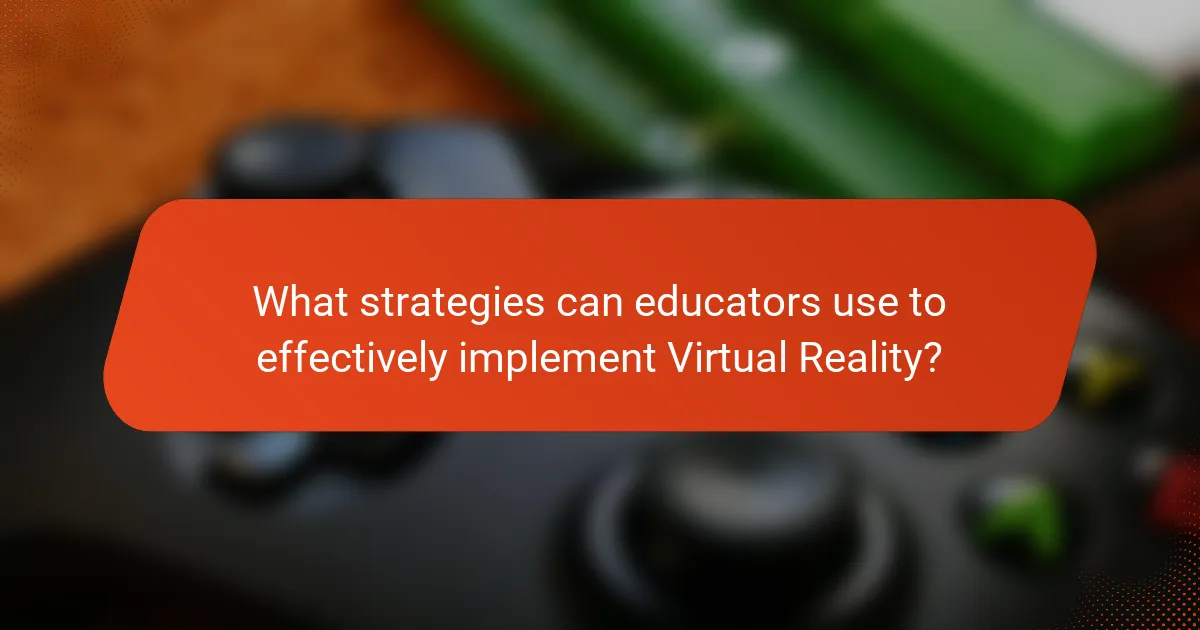
What strategies can educators use to effectively implement Virtual Reality?
Educators can effectively implement Virtual Reality (VR) by integrating it into the curriculum, providing training for teachers, and ensuring access to technology. Curriculum integration involves aligning VR experiences with learning objectives. This enhances engagement and retention of information. Teacher training is essential for maximizing the potential of VR tools. Research shows that educators who are familiar with VR technology can create more effective learning environments. Access to technology must be prioritized to ensure all students can participate. Studies indicate that equitable access to VR resources leads to improved learning outcomes. Additionally, educators should seek feedback from students to refine VR experiences. Continuous improvement based on user input fosters a more effective educational environment.
How can teachers prepare students for Virtual Reality experiences?
Teachers can prepare students for Virtual Reality experiences by providing clear instructions and setting expectations. They should introduce the technology and its purpose before the session. Familiarizing students with the VR equipment is essential. Teachers can conduct practice sessions to ensure comfort with the devices.
Establishing a safe environment is crucial for immersive experiences. Students should understand the physical space they will be using. Teachers can discuss potential challenges and how to overcome them.
Additionally, integrating VR content with the curriculum enhances relevance. Teachers can explain how the VR experience connects to learning objectives. Encouraging discussions about the experience can deepen understanding.
Research shows that effective preparation increases engagement and learning outcomes in VR settings. A study by Mikropoulos and Natsis (2011) highlights the importance of prior knowledge and comfort with technology for successful VR integration in education.
What resources are available for educators to learn about Virtual Reality?
Educators can access various resources to learn about Virtual Reality. Online platforms like Coursera and edX offer courses specifically focused on Virtual Reality in education. These courses often include lectures from industry experts and practical assignments. Additionally, organizations such as the International Society for Technology in Education (ISTE) provide guidelines and frameworks for integrating VR into teaching.
Books like “Learning in Virtual Worlds” by Jeremy Bailenson offer in-depth insights into the technology’s educational applications. Furthermore, webinars and workshops hosted by educational technology companies frequently cover VR topics.
Academic journals, such as the Journal of Educational Technology & Society, publish peer-reviewed articles on VR research and case studies. These resources collectively equip educators with the knowledge and skills necessary to implement Virtual Reality effectively in their classrooms.
How can educators assess the effectiveness of Virtual Reality in their teaching?
Educators can assess the effectiveness of Virtual Reality (VR) in their teaching by measuring student engagement and learning outcomes. They can utilize surveys to gather student feedback on their VR experiences. Pre- and post-assessments can evaluate knowledge retention and skill acquisition. Observational studies can analyze student interactions within VR environments. Performance metrics can be collected from VR applications to track progress and achievements. Research indicates that VR can enhance learning experiences, as shown in studies by Radianti et al. (2020) which highlight improved retention rates. By using a combination of these methods, educators can gain a comprehensive understanding of VR’s impact on learning.
What challenges might educators face when using Virtual Reality?
Educators may face several challenges when using Virtual Reality (VR) in the classroom. One significant challenge is the high cost of VR equipment and software. Many schools may lack the budget to invest in this technology. Another challenge is the need for technical training. Educators must learn how to operate VR systems effectively. Additionally, there can be issues with content availability. Not all subjects have sufficient VR resources. Another concern is student motion sickness. Some students may experience discomfort during VR sessions. Furthermore, integrating VR into existing curricula can be complex. Educators must find ways to align VR experiences with learning objectives. Finally, there may be accessibility issues. Not all students may have equal access to VR technology.
How can schools address technical issues related to Virtual Reality?
Schools can address technical issues related to Virtual Reality by implementing structured support systems. Technical training for staff is essential to ensure they can troubleshoot common problems. Regular maintenance of VR equipment helps prevent malfunctions. Schools should establish partnerships with technology providers for timely support and updates. Creating a dedicated IT support team can assist with immediate technical challenges. Additionally, incorporating user feedback can identify recurring issues and improve the VR experience. Research indicates that effective technical support increases the successful integration of VR in educational settings.
What are the potential costs associated with implementing Virtual Reality?
The potential costs associated with implementing Virtual Reality in education include hardware, software, and training expenses. Hardware costs can range from $200 to over $1,000 per device, depending on the quality. Software development or licensing can add thousands of dollars, with custom solutions often exceeding $50,000. Training educators and staff to effectively use VR can incur additional costs, typically ranging from $500 to $5,000 per training session. Maintenance and updates for both hardware and software also contribute to ongoing expenses. According to a report by the International Society for Technology in Education, schools may need to budget for these costs to ensure successful implementation.
What best practices should educators follow when incorporating Virtual Reality into their teaching?
Educators should follow several best practices when incorporating Virtual Reality into their teaching. First, they must ensure that the VR content aligns with learning objectives. This alignment enhances educational outcomes. Second, educators should provide adequate training for both themselves and their students. Training ensures effective use of VR technology. Third, they should create a structured plan for VR sessions. A structured plan helps manage time and resources efficiently. Fourth, educators should encourage collaboration among students during VR activities. Collaboration fosters engagement and enhances learning experiences. Fifth, they must gather feedback from students after VR sessions. Feedback allows for continuous improvement of the VR experience. Finally, educators should consider accessibility for all students. Ensuring accessibility promotes inclusivity in learning. These practices lead to more effective and engaging VR learning environments.
How can educators create inclusive Virtual Reality experiences for all students?
Educators can create inclusive Virtual Reality experiences by incorporating diverse perspectives and accessibility features. They should ensure VR content reflects various cultures, abilities, and backgrounds. This can be achieved by collaborating with diverse stakeholders during content development. Additionally, using accessible hardware and software is essential. Features such as adjustable controls and audio descriptions enhance usability for all students. Research shows that inclusive VR can improve engagement and learning outcomes. A study by Slater et al. (2019) found that immersive experiences increase empathy and understanding among students from different backgrounds. Thus, implementing these strategies can foster a more inclusive learning environment.
What tips can enhance the effectiveness of Virtual Reality in learning?
To enhance the effectiveness of Virtual Reality in learning, ensure clear learning objectives are established. Clear objectives guide the learner’s focus and intention. Incorporate interactive elements to engage users actively. Interaction increases retention and understanding of material. Use realistic simulations to provide immersive experiences. Realism helps learners connect theory to practice effectively. Encourage collaboration among learners in virtual environments. Collaboration fosters communication and teamwork skills. Provide immediate feedback within the VR experience. Immediate feedback helps learners adjust their understanding promptly. Finally, assess learning outcomes to measure effectiveness. Assessment ensures the VR experience meets educational goals.
Virtual Reality (VR) in education is an immersive technology that enhances learning experiences by simulating real-world environments and enabling interactive engagement through 3D spaces. This article explores the benefits of VR, such as improved retention rates and increased student motivation, alongside its applications across various subjects like science, history, and vocational training. Key technologies used in VR, strategies for effective integration into curricula, and best practices for creating inclusive VR experiences are also discussed. Furthermore, the article addresses potential challenges educators may face and offers insights into assessing the effectiveness of VR in teaching.
